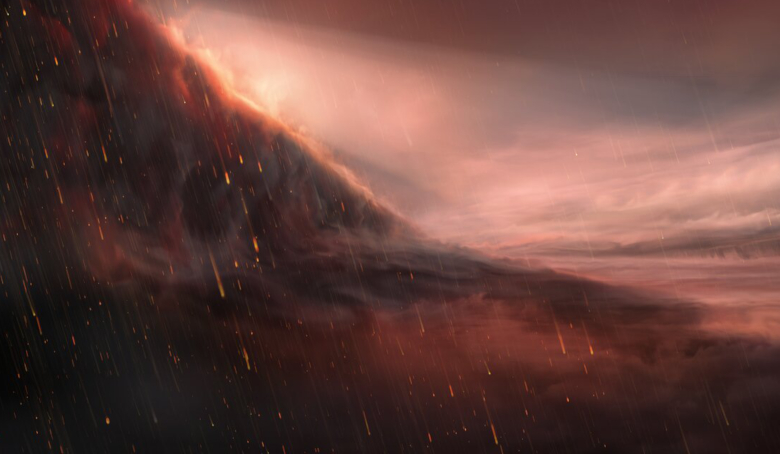If you thought monsoon season on this planet was bad enough, spare a thought for any inhabitants of WASP-76b, as signals of what might be iron rain pouring down on the nightside of this ultra-hot exoplanet has been detected by an international team of astronomers.
Ultra-hot giant exoplanets are named so because they face daily blistering temperatures of 2,000 kelvin (1727 degrees celsius) or more, due to the amount of radiation received from their host star.
In comparison, Mercury, the closest planet to the Sun in our Solar System, has a day side temperature of around 700 K (427 degrees celsius)!
These fiery planets are therefore ideal laboratories for studying the extreme climates and chemistry of worlds whose conditions are far removed from what we are used to here on Earth.
WASP-76b was first discovered in 2013 by the Wide Angle Search for Planets or WASP survey; a consortium of international academic organisations who search for exoplanets using transit photometry with an array of robotic telescopes on La Palma in the Canary Islands.
This puffed-up planet is unflatteringly referred to as a bloated-hot Jupiter, because it is nearly twice the size of our own gas giant and has a radius 20 times bigger than Earth’s.
It orbits an inflated F-type star known as WASP-76, an ageing and evolved star around 5.3 billion years old. F stars are between 1.0 to 1.4 times the mass of the Sun and this particular one has a surface temperature of around 6,250 to 6,500 K. Scientists suspect that it is these swollen star properties I.e high temperature and large radii, that give rise to these hot, bloated exoplanets.
Another curious condition of these type of planets is that the dayside, which is predicted to be cloud-free and substantially hotter than its nightside, has a different chemistry than its nightside. This dichotomy occurs because free-floating atoms on the dayside recombine into molecules over on the nightside, creating a mix of differing chemical compounds.
This contrast in chemistry is exactly what the international team of astronomers found when they looked at the atomic signatures of WASP-76b with high-dispersion spectroscopy – the study of the absorption and emission of light and other radiation by matter – using ESO’s Very Large Telescope (VLT).
The authors, whose work was just published in Nature and was led by David Ehrenreich at Observatoire astronomique de l’Université de Genève, found that WASP-76b has an iron absorption signal at the dayside-to-nightside transition, but that this same signal could not be identified at the transition from night to day. This means that iron does not absorb light at that location.
These findings say the team, suggest that the iron must condense, probably into clouds, and is then carried to the cooler night side by strong winds where it falls as iron rain.
“We conclude from this that neutral iron atoms must be present on the dayside and evening terminator, but much less abundant or even absent from the nightside and morning terminator," the authors say in their paper. “One could say that this planet gets rainy in the evening, except it rains iron,” Ehrenreich adds.
The detection of apparent infrared emission indicating nightside clouds on other hot gas giants has been suggested before and these clouds could be made out of iron droplets the authors write.
It is hoped that observations such as these will be a lot more common as the tool used to detect the iron rain, ESPRESSO — the Echelle SPectrograph for Rocky Exoplanets and Stable Spectroscopic Observations, which is mounted on the VLT — has proven to be much more versatile than than its original intended use of just looking for Earth-like planets around Sun-like stars.
“We soon realised that the remarkable collecting power of the VLT and the extreme stability of ESPRESSO made it a prime machine to study exoplanet atmospheres,” says Pedro Figueira, ESPRESSO instrument scientist at ESO in Chile.
“What we have now is a whole new way to trace the climate of the most extreme exoplanets,” concludes Ehrenreich.











